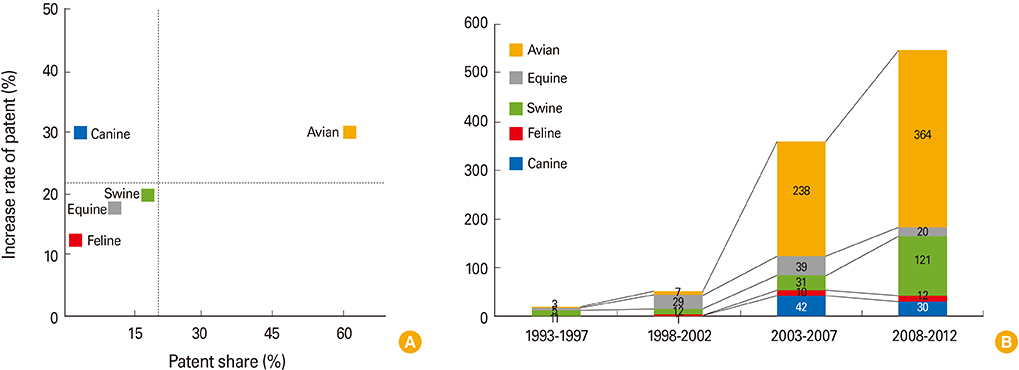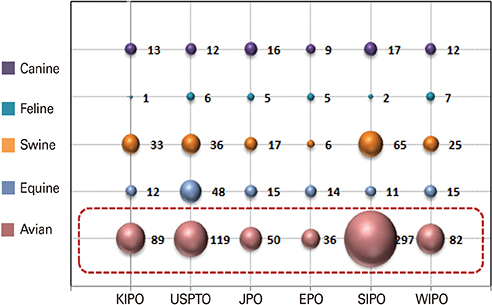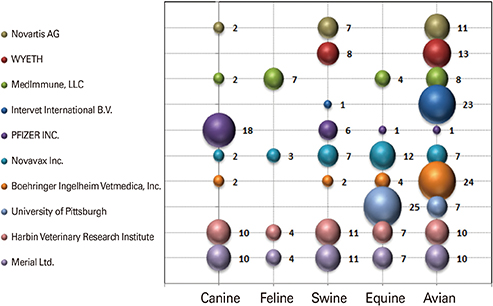Clin Exp Vaccine Res.
2016 Jul;5(2):117-124. 10.7774/cevr.2016.5.2.117.
Influenza virus vaccine for neglected hosts: horses and dogs
- Affiliations
-
- 1College of Pharmacy, Korea University, Sejong, Korea. sds1@korea.ac.kr
- 2Research Unit, Green Cross Veterinary Products, Yongin, Korea.
- KMID: 2421558
- DOI: http://doi.org/10.7774/cevr.2016.5.2.117
Abstract
- This study provides information regarding vaccine research and the epidemiology of influenza virus in neglected hosts (horses and dogs). Equine influenza virus (EIV) causes a highly contagious disease in horses and other equids, and outbreaks have occurred worldwide. EIV has resulted in costly damage to the horse industry and has the ability of cross the host species barrier from horses to dogs. Canine influenza is a virus of equine or avian origin and infects companion animals that live in close contact with humans; this results in possible exposure to the seasonal epizootic influenza virus. There have been case reports of genetic reassortment between human and canine influenza viruses, which results in high virulence and the ability of transmission to ferrets. This emphasizes the need for vaccine research on neglected hosts to update knowledge on current strains and to advance technology for controlling influenza outbreaks for public health.
Keyword
MeSH Terms
Figure
Reference
-
1. Morens DM, Taubenberger JK. An avian outbreak associated with panzootic equine influenza in 1872: an early example of highly pathogenic avian influenza? Influenza Other Respir Viruses. 2010; 4:373–377.
Article2. Sovinova O, Tumova B, Pouska F, Nemec J. Isolation of a virus causing respiratory disease in horses. Acta Virol. 1958; 2:52–61.3. Waddell GH, Teigland MB, Sigel MM. A new influenza virus associated with equine respiratory disease. J Am Vet Med Assoc. 1963; 143:587–590.4. Webster RG. Are equine 1 influenza viruses still present in horses? Equine Vet J. 1993; 25:537–538.
Article5. Watson J, Halpin K, Selleck P, et al. Isolation and characterisation of an H3N8 equine influenza virus in Australia, 2007. Aust Vet J. 2011; 89:Suppl 1. 35–37.
Article6. Daly JM, Lai AC, Binns MM, Chambers TM, Barrandeguy M, Mumford JA. Antigenic and genetic evolution of equine H3N8 influenza A viruses. J Gen Virol. 1996; 77(Pt 4):661–671.
Article7. Murcia PR, Baillie GJ, Stack JC, et al. Evolution of equine influenza virus in vaccinated horses. J Virol. 2013; 87:4768–4771.
Article8. Karamendin K, Kydyrmanov A, Kasymbekov Y, et al. Continuing evolution of equine influenza virus in Central Asia, 2007-2012. Arch Virol. 2014; 159:2321–2327.
Article9. Crawford PC, Dubovi EJ, Castleman WL, et al. Transmission of equine influenza virus to dogs. Science. 2005; 310:482–485.
Article10. Payungporn S, Crawford PC, Kouo TS, et al. Influenza A virus (H3N8) in dogs with respiratory disease, Florida. Emerg Infect Dis. 2008; 14:902–908.
Article11. Songserm T, Amonsin A, Jam-on R, et al. Fatal avian influenza A H5N1 in a dog. Emerg Infect Dis. 2006; 12:1744–1747.
Article12. Maas R, Tacken M, Ruuls L, Koch G, van Rooij E, Stockhofe-Zurwieden N. Avian influenza (H5N1) susceptibility and receptors in dogs. Emerg Infect Dis. 2007; 13:1219–1221.
Article13. Song D, Kang B, Lee C, et al. Transmission of avian influenza virus (H3N2) to dogs. Emerg Infect Dis. 2008; 14:741–746.
Article14. Song D, Lee C, Kang B, et al. Experimental infection of dogs with avian-origin canine influenza A virus (H3N2). Emerg Infect Dis. 2009; 15:56–58.
Article15. Sun Y, Sun S, Ma J, et al. Identification and characterization of avian-origin H3N2 canine influenza viruses in northern China during 2009-2010. Virology. 2013; 435:301–307.
Article16. Bunpapong N, Nonthabenjawan N, Chaiwong S, et al. Genetic characterization of canine influenza A virus (H3N2) in Thailand. Virus Genes. 2014; 48:56–63.
Article17. Song D, Moon HJ, An DJ, et al. A novel reassortant canine H3N1 influenza virus between pandemic H1N1 and canine H3N2 influenza viruses in Korea. J Gen Virol. 2012; 93(Pt 3):551–554.
Article18. Kawaoka Y, Bean WJ, Webster RG. Evolution of the hemagglutinin of equine H3 influenza viruses. Virology. 1989; 169:283–292.
Article19. Lai AC, Chambers TM, Holland RE Jr, et al. Diverged evolution of recent equine-2 influenza (H3N8) viruses in the Western Hemisphere. Arch Virol. 2001; 146:1063–1074.
Article20. Webster RG, Bean WJ, Gorman OT, Chambers TM, Kawaoka Y. Evolution and ecology of influenza A viruses. Microbiol Rev. 1992; 56:152–179.
Article21. Qi T, Guo W, Huang W, et al. Isolation and genetic characterization of H3N8 equine influenza virus from donkeys in China. Vet Microbiol. 2010; 144:455–460.
Article22. Hayward JJ, Dubovi EJ, Scarlett JM, Janeczko S, Holmes EC, Parrish CR. Microevolution of canine influenza virus in shelters and its molecular epidemiology in the United States. J Virol. 2010; 84:12636–12645.
Article23. Yang X, Liu C, Liu F, et al. Identification and genetic characterization of avian-origin H3N2 canine influenza viruses isolated from the Liaoning province of China in 2012. Virus Genes. 2014; 49:342–347.
Article24. Ogilvie TH. Large animal internal medicine. Ames, IA: Blackwell Publishing;2005.25. McGavin MD, Zachary JF. Pathologic basis of veterinary disease. St. Louis, MO: Mosby Elsevier;2007.26. Wiley DC, Wilson IA, Skehel JJ. Structural identification of the antibody-binding sites of Hong Kong influenza haemagglutinin and their involvement in antigenic variation. Nature. 1981; 289:373–378.
Article27. Shors T. Understanding viruses. Sudbury, MA: Jones and Bartlett Publishers;2009.28. Webster RG, Sharp GB, Claas EC. Interspecies transmission of influenza viruses. Am J Respir Crit Care Med. 1995; 152(4 Pt 2):S25–S30.
Article29. Murphy BR, Sly DL, Tierney EL, et al. Reassortant virus derived from avian and human influenza A viruses is attenuated and immunogenic in monkeys. Science. 1982; 218:1330–1332.
Article30. Na W, Lyoo KS, Song EJ, et al. Viral dominance of reassortants between canine influenza H3N2 and pandemic (2009) H1N1 viruses from a naturally co-infected dog. Virol J. 2015; 12:134.
Article31. Gorman OT, Bean WJ, Kawaoka Y, Donatelli I, Guo YJ, Webster RG. Evolution of influenza A virus nucleoprotein genes: implications for the origins of H1N1 human and classical swine viruses. J Virol. 1991; 65:3704–3714.
Article32. Daly JM, Blunden AS, Macrae S, et al. Transmission of equine influenza virus to English foxhounds. Emerg Infect Dis. 2008; 14:461–464.
Article33. Kirkland PD, Finlaison DS, Crispe E, Hurt AC. Influenza virus transmission from horses to dogs, Australia. Emerg Infect Dis. 2010; 16:699–702.
Article34. Songserm T, Amonsin A, Jam-on R, et al. Avian influenza H5N1 in naturally infected domestic cat. Emerg Infect Dis. 2006; 12:681–683.
Article35. Giese M, Harder TC, Teifke JP, et al. Experimental infection and natural contact exposure of dogs with avian influenza virus (H5N1). Emerg Infect Dis. 2008; 14:308–310.
Article36. Yin X, Zhao FR, Zhou DH, Wei P, Chang HY. Serological report of pandemic and seasonal human influenza virus infection in dogs in southern China. Arch Virol. 2014; 159:2877–2882.37. Song D, Kim H, Na W, et al. Canine susceptibility to human influenza viruses (A/pdm 09H1N1, A/H3N2 and B). J Gen Virol. 2015; 96(Pt 2):254–258.
Article38. Moon H, Hong M, Kim JK, et al. H3N2 canine influenza virus with the matrix gene from the pandemic A/H1N1 virus: infection dynamics in dogs and ferrets. Epidemiol Infect. 2015; 143:772–780.
Article39. Lyoo KS, Na W, Yeom M, et al. Virulence of a novel reassortant canine H3N2 influenza virus in ferret, dog and mouse models. Arch Virol. 2016; 161:1915–1923.
Article40. Yamanaka T, Nemoto M, Tsujimura K, Kondo T, Matsumura T. Interspecies transmission of equine influenza virus (H3N8) to dogs by close contact with experimentally infected horses. Vet Microbiol. 2009; 139:351–355.
Article41. Paillot R. A systematic review of recent advances in equine influenza vaccination. Vaccines (Basel). 2014; 2:797–831.42. Chambers TM, Holland RE, Tudor LR, et al. A new modified live equine influenza virus vaccine: phenotypic stability, restricted spread and efficacy against heterologous virus challenge. Equine Vet J. 2001; 33:630–636.
Article43. Minke JM, Toulemonde CE, Coupier H, et al. Efficacy of a canarypox-vectored recombinant vaccine expressing the hemagglutinin gene of equine influenza H3N8 virus in the protection of ponies from viral challenge. Am J Vet Res. 2007; 68:213–219.
Article44. Minke JM, Toulemonde CE, Dinic S, Cozette V, Cullinane A, Audonnet JC. Effective priming of foals born to immune dams against influenza by a canarypox-vectored recombinant influenza H3N8 vaccine. J Comp Pathol. 2007; 137:Suppl 1. S76–S80.
Article45. Larson LJ, Henningson J, Sharp P, et al. Efficacy of the canine influenza virus H3N8 vaccine to decrease severity of clinical disease after cochallenge with canine influenza virus and Streptococcus equi subsp. zooepidemicus. Clin Vaccine Immunol. 2011; 18:559–564.
Article46. Deshpande MS, Jirjis FF, Tubbs AL, et al. Evaluation of the efficacy of a canine influenza virus (H3N8) vaccine in dogs following experimental challenge. Vet Ther. 2009; 10:103–112.47. Kang YM, Kim HM, Ku KB, Park EH, Yum J, Seo SH. H3N2 canine influenza virus causes severe morbidity in dogs with induction of genes related to inflammation and apoptosis. Vet Res. 2013; 44:92.
Article48. Lee C, Jung K, Oh J, et al. Protective efficacy and immunogenicity of an inactivated avian-origin H3N2 canine influenza vaccine in dogs challenged with the virulent virus. Vet Microbiol. 2010; 143:184–188.
Article




